Despite the recovery of the North American housing market, B.C. lumber producers had a rough start to the year, as weather and the Vancouver truckers’ strike led to disruptions that are now showing up in first quarter results.
Of the five Western Canadian companies that have released their results, revenues are down 2.2% from the first quarter of 2013, PricewaterhouseCoopers vice-president Jason Boyer told the consulting firm’s annual global forestry conference May 6.
“The first quarter certainly was challenging for lumber,” he told delegates at the daylong Vancouver conference.
Once the pain of the transportation disruptions is over, however, the rest of the year is looking brighter for the sector, said Bruce McIntyre, Canadian leader of PwC’s global forest paper and packaging practice.
“Generally what we are probably going to see is a softer second quarter then picking up in the second half of the year. We think we are going to round out to a reasonably successful year for 2014,” he said in an interview.
The theme of the conference was optimistic, Building for the Future. It was underscored by an average return on equity of 5.3% for the global industry in 2013 and a 16% increase in revenues over 2012 for Western Canadian producers. U.S. companies had even stronger financial performance.
It has continued in 2014, with an earnings increase of 19%. That kind of financial strength has opened up opportunities for them to go on the acquisition trail, McIntyre said.
In B.C., however, the port truckers’ strike in March wiped out 28 days of shipments – almost an entire month. The unusually harsh winter weather that crippled rail transport did the rest. Further, the forestry sector lacked the political clout of the grain sector to have rail cars allocated for shipments.
That prompted Hardy Wentzel, vice-president of sales, marketing and logistics at Vernon-based Tolko Industries, to call for a united front of forest products companies over the long-standing issue of transportation.
“As a result of these challenges, our industry has struggled to meet the needs of its customers,” he told the conference. “Our industry has to find a better way to move our products.
“We have to do something as an industry to work more collaboratively with one other,” he said. “I really think it’s time for our industry to do something similar to what the Canadian grain industry has done. They have organized themselves so that they receive some preferential services from the railroads. It’s high time that our industry did the same.”
In an interview, Boyer described the impact of the transportation crisis, saying that on his daily Skytrain commute across the Fraser River, he sees reload centres and docks that are still packed with unshipped lumber. It’s expensive to store and is causing disruptions for customers.
“You should see South Surrey right now. Those docks are stacked with lumber. And it’s still just sitting there. It will be interesting to see what happens to Q2 earnings just on the back of releasing all that expensive inventory.”
McIntyre said that the forest sector has been let down.
“It’s a very sensitive issue. We can’t afford the kinds of disruptions we have seen both in rail and in trucking in the last few months.
“It’s the high cost, but even more important, is the reliability,” he said.
“We are far away from our markets. We don’t have a local market. If we don’t have transportation systems, we don’t have a business.
On other fronts, Boyer said the industry continues to attract foreign investment and as the U.S. market returns to its historical levels of 1.5 million housing starts a year, he expects Asian investors will begin buying assets in B.C. and the U.S. Pacific Northwest in order to secure fibre supplies.
McIntyre also pointed out that B.C. players are continuing to invest outside the province, driven by the scarcity of timber in mountain pine-beetle-affected areas, and logistics issues surrounding transportation.
“You can see pretty obviously the strategy of the B.C lumber producers. If you look at West Fraser, Canfor and Interfor, they are all investing in the U.S. West Fraser now has more operations outside B.C than inside B.C. I think they are following two things primarily, It’s the fibre supply risk and the second one is moving closer to your markets. The closer you are to your market the lower your costs are.”
@bizinvancouver




